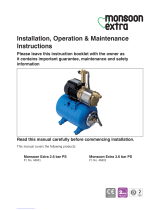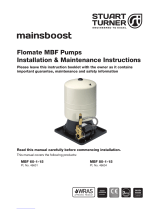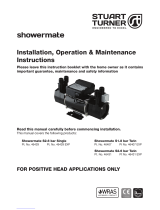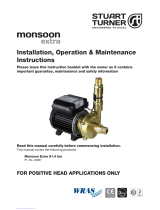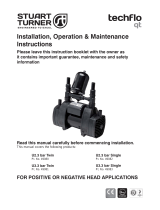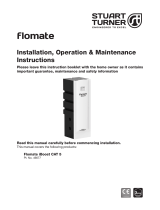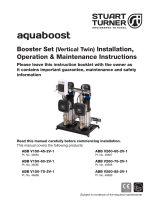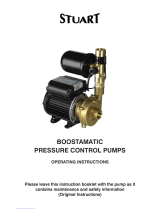Page is loading ...

Installation, Operation & Maintenance
Instructions
Please leave this instruction booklet with the owner as
it contains important guarantee, maintenance and safety
information
Read this manual carefully before commencing installation.
This manual covers the following products:
CE compliant product
CH 4-30 B
Pt. No. 46593
CH 4-40 B
Pt. No. 46594
CH 4-50 B
Pt. No. 46595
CH 4-60 B
Pt. No. 46610
FOR POSITIVE OR NEGATIVE HEAD APPLICATIONS
50 Hz

- 2 -
Cont ...
PRODUCT DESCRIPTION
Electric motor driven centrifugal pump complete with an automatic control system,
consisting of flow switch, pressure switch, pressure vessel and electronic control.
APPLICATION
The Stuart CH Boostamatic range is designed for pressure boosting applications in
vented stored, hot or cold, clean water systems, where under gravity, no flow is available
and can be used in systems where either a positive or negative head exists.
Inlet pressures to the pump and ambient temperatures must not exceed the
values given in the technical specifications.
zThis pump set must not be used for any other
application without the written consent of Stuart
Turner Limited.
zThis pump MUST NOT be connected directly to
the mains water supply.
zThis appliance can be used by children aged from
8 years and above and persons with reduced
physical, sensory or mental capabilities or lack of
experience and knowledge if they have been given
supervision or instruction concerning use of the
appliance in a safe way and understand the
hazards involved. Children shall not play with the
appliance. Cleaning and user maintenance shall
not be made by children without supervision.
zChildren should be supervised to ensure that they
do not play with the appliance
zThis product should not be used for the supply of
water to more than one dwelling (house,
apartment, flat).
Please read installation details carefully as they are intended to ensure this
product provides long, trouble free service. Failure to install the unit in
accordance with the installation instructions will lead to invalidation of the
warranty.
STORAGE
If this product is not to be installed immediately on receipt, ensure that it is stored in a dry,
frost and vibration free location in its original packaging.

- 3 -
Cont ...
CONTENTS Page
Checklist ............................................................4
Pre-Installation .......................................................5
Important Facts - read before commencing installation .......................6
Location ............................................................7
Pump Connections ....................................................12
Electrical Installation ...................................................13
Commissioning .......................................................15
Maintenance .........................................................16
Technical Specication .................................................18
Trouble Shooting .....................................................20
Guarantee ...........................................................23

- 4 -
Cont ...
CHECKLIST
Note: Item C & G are supplied loose and will require fitting to the pump inlet/outlet.
Tighten to torque 4/5 Nm.
Your product may vary slightly from the picture above.
Item Description Qty Item Description Qty
Pump 1 Inline strainer 1
Hose & sealing washer 2 Pressure vessel 1
Inlet connector & ‘O’-ring 1 Outlet connector & ‘O’-ring 1
Anti-vibration feet 5
A
B
C
D
E
F
G
Fig. 1
28 mm copper
inlet pipework
(suction).
28 mm isolating valve
(non restrictive) and
fittings (not supplied)
must be fitted to allow
easy pump service.
28 mm copper outlet pipework (discharge).
Short 28 mm copper pipe
tails to connect between
isolating valve and flexible
pipes.
28 mm isolating valve
(non restrictive) and
fittings (not supplied)
to allow easy pump
service.
28 mm - G 1 connector
(not supplied) must
be fitted
28 mm flexible
pipes. These
hoses are fitted
with G 1 female
connector suitable
for connection to a G 1 (1 “ BSP)
adaptor or fitting.
A
B
C
D
E
FG
IMPORTANT: With the pump
removed from its packaging check
for any damage prior to installation.
If any damage is found contact
Stuart Turner Ltd within 24 hours of
receipt.
B
Note: This image is for reference only.

- 5 -
Fig. 2
Grub Screws
(3 off)
Outlet Tower can be swivelled at
this joint line after loosening the
3 equi-spaced grub screws
PRE-INSTALLATION ASSEMBLY
Re-positioning of Pressure Vessel
The pressure vessel can be rotated to alternative positions (Fig. 3) in the event of the
factory fitted position being unsuitable for a specific installation.
a) Remove pressure vessel by unscrewing anti-clockwise.
b) Using a 2 mm allen key, carefully loosen all three retaining grub screws by two
turns (Fig. 2).
c) Warning - Care must be taken when re-positioning the pressure vessel to
ensure no strain is placed upon the pressure
switch or reed switch cables.
The flow switch assembly can now be carefully
rotated to an alternative position
(Fig. 3).
d) Ensure all three grub screws
are re-tightened securely to
a torque of 2.2 Nm (1.62 ft lbf).
e) Re-fit the pressure vessel
ensuring the ‘O’-ring seal
is in place.
Motor
Area for alternative fitting positions
Factory fitted position all models
Fig. 3
Note: These images are for
reference only

- 6 -
Cont ...
1 IMPORTANT FACTS: READ BEFORE COMMENCING PUMP INSTALLATION
A. Water storage capacity.
1.11 The hot and cold water storage capacity (must be a minimum of 230 litres) and
sufficient to meet the flow rates required by the pumped equipment and any
other water using fittings and appliances, which may be operated
simultaneously.
1.12 Ensure the pump is primed as described in the priming section before starting,
damage to the shaft seal will result otherwise. See Section 5 - Commissioning.
B. Water temperature
The water entering the pump must be controlled as follows:
1.13 The maximum allowable water temperature is 65 oC.
1.14 The minimum allowable water temperature is 4 oC.
1.15 DO NOT fit a pump if the hot water is heated via a method whereby the water
temperature cannot be controlled, such as solar or solid fuel you must consult
the PumpAssist team on +44 (0) 800 31 969 80.
C. Pipework - General
1.16 Secure pipework: Ensure pipework to and from pump is independently
supported & clipped to prevent forces being transferred to inlet and outlet
branches of pump.
1.17 Flux: Solder joints must be completed and flux residues removed prior to pump
installation (flux damage will void any warranty).
1.18 Pipework design: Care should be taken in the design of pipework runs to
minimize the risk of air locks e.g. use drawn bends rather than 90o bends.
1.19 DO NOT introduce solder flux to flexible hoses, pumps or pump parts
manufactured from plastic.
1.20 DO NOT allow contact with oil or cellulose based paints, paint thinners or
strippers, acid based descalents or aggressive cleaning agents.
1.21 DO NOT install a non-return valve, or devices which contain non-return
valves, in the suction (inlet) pipework to the pump. The pump must be
free to vent to the supply tank at all times.
1.22 DO NOT bend the flexible hoses beyond 30o. They must be installed as
straight as possible.
1.23 DO NOT connect this pump to the mains water supply.
D. Plumbing Installation Regulations
1.24 The plumbing installation must comply with the current water and building
regulations.
1.25 The plumbing installation must be installed by a qualified person.
1.26 The electrical installation must be carried out in accordance with the current
national electrical regulations.
1.27 The electrical installation must be installed by a qualified person.
E. Pressure vessel
1.28 Pressure vessel is charged at the factory see Section 5 - Maintenance for
details.

- 7 -
Cont ...
2 LOCATION - GENERAL
2.11 Access: For emergencies and maintenance the pump must be
easily accessible.
2.12 Protection: The pump must be located in a dry position, frost
free and protected from freezing, particularly when installed in a loft
(not recommended).
2.13 Ventilation: Ensure an adequate air flow to cool the pump. Separate
the pump from other appliances that generate heat. An 80 mm (3 “)
air gap must be maintained around the pump.
2.14 Safety: The motor casing can become very hot under normal
operating conditions. Care must be taken to ensure it cannot be
touched during operation.
2.15 Water retention: Site the pump in a location where in the unlikely
event of a water leak, any spillage is contained or routed to avoid
electrics or areas sensitive to water damage.
2.16 Static inlet pressure: Before deciding where to locate the unit check to ensure
the static inlet head between pump and the bottom of the cold water tank
(Figs. 4 & 5) is at least 1 metre and does not exceed the max inlet head of
10 metres.
2.17 Ambient temperature: The pump must be sited in a location where the
maximum ambient temperature does not exceed 40 oC continuous or 50 oC
intermittent.
2.18 Pipework: For optimum performance pipework use 28 mm dia., 22 mm can be
used but will result in reduced pump performance. Note: Inlet pipework must
always be greater than or equal to the outlet pipework diameter.
Pipework should only reduce to 15 mm when entering terminal fitting.
2.19 Static outlet pressure: The static outlet head (Figs. 4 & 5) must also be within
the maximum requirement of 13 metres.
2.20 Noise: The anti-vibration mounting feet and flexible hoses which are supplied
as standard, and a precaution to reduce noise transmission, however care must
be taken when mounting the pump that any noise is not amplified through loose
panels or pipework. Do not screw down the pump.
2.21 Direction of flow: Ensure the water flow is in the direction of the arrow marked
on the flow switch reed clamp (vertically upwards).
2.22 Flexible hoses: Only use the Stuart Turner hose set supplied with the pump.
2.23 Isolating valves: Separate system isolating valves (non restrictive) must be
fitted to allow easy pump service.
2.24 Preferred pump location: The pump must, for optimum performance, be sited
as close as possible to and never more than 4 metres from the HOT WATER
cylinder. The pump should always be sited BELOW the HOT WATER take-off
from the cylinder. The pump location is also dependent on limitations of
the static inlet and outlet heads of the installation. For guidance on limitations
and recommended location, consult the following relevant section for hot or cold
water installation.

- 8 -
Cont ...
2 LOCATION - COLD WATER INSTALLATION
2.25 The cold water supply: Must be a DEDICATED AIR FREE supply via a tank
connector, and must be positioned at a slightly lower level (25 mm minimum)
than the feed pipe to the hot water cylinder.
Do not connect to the mains.
Fig. 4
Cold water
pump
Static inlet pressure
Min. 1 m
Max. 10 m
Static outlet pressure
Max. 13 m

- 9 -
Cont ...
2.26 Hot water cylinder or storage tank: When a hot water cylinder or storage
tank is used, ensure the pipework size from the cold water storage to the hot
water storage is of adequate size and a minimum of 28 mm.
2.27 Hot water supply: The pump must be supplied with a dedicated feed direct
from the hot water cylinder or storage tank which should be via a secondary
dedicated tapping (see Fig. 6).
Do not connect to the mains.
2 LOCATION - HOT WATER INSTALLATION
Fig. 5
Hot water
pump
Static inlet pressure
Min. 1 m
Max. 10 m
Static outlet pressure
Max. 13 m
Fig. 6
with rising
28 mm offset
expansion pipe
and pump.
Factory installed
secondary tapping with
28 mm pipework to
pump.

- 10 -
Cont ...
2.28 Pump Mounted Above Liquid Source (Suction Lift Installation):
2.29 The pumps can be used in a suction lift installation providing the height of lift is
within the limits specified in the limits of application section and the liquid to be
pumped is cold water (for applications other than cold water contact Stuart
Turner).
2.30 Before deciding where to locate the unit, check to ensure the static outlet head
(Fig. 7) does not exceed the maximum requirements 13 metres.
2.31 A footvalve and strainer may be used and the suction pipework size must match
the pump.
2.32 Lay the suction piping over the shortest possible distance and ensure there is a
constant rise from the liquid source to the pump. Any high spots will cause air
pockets to form, reducing system efficiency.
2.33 Ensure all joints in suction pipework are completely airtight. Failure to comply
will result in loss of prime.
2.34 The intake of the footvalve/strainer should be positioned such that it cannot be
blocked with debris or silt that are frequently found in the bottom of sumps and
wells.
2.35 When a footvalve is installed in the suction pipework, it is recommended that
suitable pressure relief valve be fitted in the discharge (outlet) pipework from the
pump.
Fig. 7
Diagram showing typical Pressure Control
installation with suction lift.
Max. suction lift 4.6 m
Max. static outlet pressure 13 m
Note: This image is for
reference only

- 11 -
Cont ...
2.36 Non-Preferred Pump Location: The pump must be located with at least
1 metre flooded suction at all times.
If it is not possible to locate the pump in the preferred area due to site limitations
and it is necessary to position the unit in the loft, or in a position above the
secondary tapping that feeds the pump, then there is an increased risk of air
locks. This risk must be eliminated.
The following method will help to overcome the problem:
In this application only use an Essex or side entry flange, then fit a “U” bend or
downward loop in the supply pipe to the pump of 350 mm depth before rising to
the pump should ensure the cylinder vents its air up the expansion pipe, not up
the pump feed (Fig. 8).
Max. static inlet pressure 10 m
Min. static inlet pressure 1 m
350 mm
min.
Least preferred area
Fig. 8

- 12 -
Cont ...
3 PUMP CONNECTIONS
3.11 Hose to pump: These pumps have G 1 threaded connections to accept the
hoses supplied. The hose end is made water tight with a sealing washer on
assembly, nip tight to 4/5 Nm for water tight seal (Do not overtighten).
3.12 Hose to pipework: Hoses terminating in G 1 threaded connections are
supplied and when securing the male end to a suitable pipe fitting, seal with
PTFE tape or other suitable sealant.

- 13 -
Cont ...
4 ELECTRICAL INSTALLATION / EARTHING
4.11 Regulations: The electrical installation must be carried out in
accordance with the current national electrical regulations and installed
by a qualified person.
4.12 Safety: In the interests of electrical safety a 30 mA residual current
device (R.C.D. not supplied) should be installed in the supply circuit.
This may be part of a consumer unit or a separate unit.
4.13 Before starting work on the electrical supply ensure power supply is
isolated.
4.14 DO NOT allow the supply cord to contact hot surfaces, including the
motor shell, pump body or pipework. The cord should be safely routed
and secured by cable clips.
4.15 Adjacent pipes: Adjacent suction and
delivery pipes should be fitted with
earthing clamps in accordance with
current regulations (Fig. 9).
4.16 Earthing: This appliance must be earthed via the supply cord, which must be
correctly connected to the earth point located in the terminal box.
4.17 Pipework: Copper or metallic pipework must have supplementary earth
bonding where the continuity has been broken by flexible hoses or plastic
components (not supplied).
4.18 Additional earthing: Certain installations may require additional earthing
arrangements such as equipotential bonding. Reference should be made to the
relevant regulations concerning this subject to ensure compliance.
4.19 Connections: The pump must be permanently connected to the fixed wiring of
the mains supply using the factory fitted supply cord, via a double pole
switched fused spur off the ring main and NOT connected to the boiler or the
immersion heater circuits.
4.20 Wiring of connection unit:
WARNING: This appliance must be earthed.
The wires in the mains lead are coloured in accordance with the following code:
Green and Yellow: Earth Blue: Neutral Brown: Live
As the colours of the wires in the mains lead of this appliance may not
correspond with the coloured markings identifying the terminals in your
connection unit proceed as follows:
The wire which is coloured green and yellow must be connected to the terminal
in the connection unit which is marked with the letter E or by the earth
symbol: or coloured green or green and yellow.
The wire which is coloured blue must be connected to the terminal which is
marked with the letter N or coloured black.
The wire which is coloured brown must be connected to the terminal which is
marked with the letter L or coloured red.
Diagram of
earth continuity
connections
Fig. 9

- 14 -
4.23 Supply Cord Replacement:
The supply cord and internal wiring within the terminal
box are routed and secured to ensure compliance with the
electrical standard EN 60335-1. It is essential that prior to
any disturbance of this internal wiring, all cable routing and
securing details are carefully noted to ensure re-assembly to
the same factory pattern is always maintained.
If the supply cord is to be changed or is damaged, it must be replaced with a
special cord assembly available from Stuart Turner or one of their approved
repairers.
On disassembly note the cord retention and routing system. Re-assemble to the
same pattern.
For information on cable connection consult the wiring diagram and cable gland
fitting instructions.
4.24 Cable Gland Fitting Instructions:
To enable correct assembly of the cable gland the
‘O’-ring (Fig. 11 item 1) must be placed over the cable
before the clamping insert (Fig. 11 item 2) can be
tightened.
Note: Cable diameter range:- 9.2 mm to 11.9 mm.
4.25 Supply Cord Extension:
The pumps are fitted with a supply cord to the
following specification:-
All models ..............HO7RN-F3 G 1.5 mm² - 10 Amp rated cable.
If the supply cord is to be extended, a cord of the same specification should be
used. Any connections or junction boxes used should be specifically suited for
the application and installed in accordance with the manufacturers instructions.
4.21 Wiring Diagram:
Model Fuse Size (AMPS)
All Models 13
4.22 Fuses: The following fuse size should be used with the appropriate pump:
Fig. 11
2
1
GREEN / YELLOW
BLUE
BROWN L
E
N230 VAC/1PH/50Hz
SUPPLY
RED
CAPACITOR
MOTOR
GREEN / YELLOW (LINK WIRE)
RED
YELLOW
RED
BLACK
BLACK
FLOWSWITCH
REED (S3)
PRESSURE
SWITCH (S1)
S3 S3 S2S2S1 S1
NL
N
M
All models
Fig. 10

- 15 -
5.14 Starting:
a) Ensure all outlets are closed, turn power supply ‘on’ - pump will start,
pressurise the system then stop.
b) Open and close all outlets in turn associated with the pump, (including w/c
systems) allowing water to flow from each outlet until all air is purged. As
each outlet is opened and closed, the pump will start and stop respectively.
Note: After closing the outlet there will be a small time delay before the
pump stops, which is normal.
c) Any tap or control valve within the system when opened and closed will now
turn the pump on/off. Providing this is the case the system is now operating
correctly.
d) Carefully check pump and pipework for leaks whilst pump running and
stationary before leaving the installation unattended.
5.15 For Further Technical Support: Phone the Stuart Turner PumpAssist team
on +44 (0) 800 31 969 80. Our staff are trained to help and advise you over the
phone.
5 COMMISSIONING / SYSTEM FLUSHING/ PRIMING / STARTING
5.11 System Flushing: The pipework system should be flushed out
prior to the pump being connected to ensure any contaminants/
chemical residues and foreign bodies are removed from elsewhere
in the system.
5.12 Water Supply: Always ensure that water storage capacity is adequate to meet
the demand. Ensure the pump chamber is full of water before starting the
pump. Failure to do this could result in seal damage. To ensure dry running
does not occur the pump must be primed as described in priming section below.
Do not run pump dry.
5.13 Priming:
Never operate pump with inlet and/or outlet isolating valves in
the closed position. Damage will occur!
The pump must be primed (filled with water) before starting.
Turn on the service valves and vent/prime pump head.
(a) Loosen priming plug and allow an even flow of water this may take a
few seconds.
(b) Re-seal draining plug, nipping tight. The pump is now ready to start.
Fig. 12
Priming
Plug
Vent
Plug
Note: This image is for
reference only

- 16 -
Cont ...
6 MAINTENANCE
6.11 Disconnect electrical supply before working on the pump.
6.12 Turn off water supplies to the pump and release pressure by
opening water outlets before attempting maintenance.
6.13 Inlet strainer: Incorporated in the strainer is a removable gauze filter which
may require periodic cleaning. The frequency of this operation is dependent
upon installation conditions.
The strainer is located in the inlet pipework to the pump (Fig. 13). The gauze
filter is removed as follows:-
a) Isolate pump electrically.
b) Release all system pressure.
c) Isolate water supply.
d) Remove screwed hexagonal plug from strainer body taking care to collect or
absorb any residual water (Fig. 13).
e) Remove and clean stainless steel gauze filter.
f) Reassemble gauze and secure plug tightly.
g) Turn on water supplies, connect power supply and test.
6.14 Pressure vessel: The pressure vessel should be checked once every 6 months
to have its air charge checked or replenished, this should be carried out as
follows:-
a) Isolate pump electrically.
b) Isolate the water supply by closing the appropriate isolating valves.
c) Release system water pressure by opening a system outlet on the system.
d) Remove pressure vessel from the pump taking care to collect or absorb any
residual water using towels.
e) Check air charge at Schrader valve (Fig. 14) using a tyre pressure gauge.
f) Replenish air charge if required by injecting air into the vessel via the
Schrader valve using a car or bicycle pump (Fig. 14).
g) Reassemble pressure vessel to pump hand tight to achieve a water tight
connection. Ensure sealing ‘O’-ring is in place.
h) Close all system outlets, open inlet and outlet isolating valves.
i) After maintenance is completed refer to Section 5 - Commissioning for
instructions on re-starting pump.
Strainer
Gauze
Gasket
Hex plug
Fig. 13

- 17 -
Cont ...
6.15 Water scale: As water is heated scale deposits are released in areas of hard
water, scale can cause the mechanical seal to stick if left without use for long
periods. The pump must be run for at least 5 minutes every four weeks to
“exercise” all working parts. Run on cool water. See Section 7 - Technical
Specification for note on water temperature. This particularly applies to guest
bathrooms used infrequently.
6.16 Cleaners, Disinfectants and Descalents:
Acid based descalents and aggressive cleaning agents must not
come into contact with the pump. The pump must be removed from
the system prior to the use of these products. The system should be
flushed to remove all chemicals before the pump is re-connected.
If in any doubt as to the suitability of the chemical solutions, please
contact our PumpAssist helpline on +44 (0) 800 31 969 80.
Fig. 14
Detail view of
‘O’-Ring groove
in fitting point
‘O’-Ring
Schrader valve
(under cap)
Pressure vessel
‘O’-Ring
Fitting point
Model Air Charge
bar (psi)
CH 4-30 B 1.3 (19)
CH 4-40 B 1.8 (26.1)
CH 4-50 B
CH 4-60 B 2.8 (46.6)
NOTE: Do not over tighten pressure vessel.
Note: This image is for
reference only

- 18 -
Cont ...
7 TECHNICAL SPECIFICATION
Pump Model
CH 4-30 B
50 Hz
46593
CH 4-40 B
50 Hz
46594
CH 4-50 B
50 Hz
46595
CH 4-60 B
50 Hz
46610
General Guarantee 2 years
WRAS approval 1601057 1601035
Features Pump type Centrifugal
Mechanical seal EDPM / Carbon / Ceramic
Anti-vibration feet ü ü ü ü
Inlet strainer(s) ü ü ü ü
Flexible hoses 2 2 2 2
Run on Timer 3 sec 3 sec 3 sec 3 sec
Dry run protection üüüü
Materials Pump body Brass / stainless steel
Impeller Stainless steel
Performance Maximum head (closed valve) 2.6 bar 3.8 bar 5.1 bar 6.4 bar
Performance @ 20 l/min 2.4 bar 3.6 bar 4.9 bar 6.2 bar
Performance @ 100 l/min 1.0 bar 1.6 bar 2.6 bar 3.9 bar
Maximum flow 120 l/min 125 l/min 135 l/min 138 l/min
Minimum static inlet pressure 1 metre
Maximum static inlet pressure 10 metres
Maximum static outlet pressure 13 metres
Maximum working pressure* 600 kPa (6 bar) 900 kPa (9 bar)
Max. ambient air temperature (continuous) 40 oC
Max. ambient air temperature (intermittent) 50 oC
Min / Max water temperature** Min 4 oC / Max 65 oC
Max. suction lift*** 4.6 metres
Cut out flow 1 l/min (approx)
Cut in pressure 140 kPa (1.4 bar) 190 kPa (1.9 bar) 290 kPa (2.9 bar)
Pressure vessel air pre-charge 1.3 bar (19 psi) 1.8 bar (26.1 psi) 2.8 bar (40.6 psi)
Connections Pump connections G 1 male
Flexible hoses Connections G 1 male x G 1 female x 300 mm long
Motor Type Induction, auto-reset thermal trip
Duty rating Continuous (S1)
Electrical Power supply / phase / frequency 230 V a.c. / 1 / 50 Hz
Current (full load) 3.6 Amps 5.4 Amps 7.3 Amps 8.8 Amps
Power consumption 800 Watts 1193 Watts 1650 Watts 1986 Watts
Fuse rating 13 Amps
Power cable (pre-wired) 1.5 metres
Physical Enclosure protection IPX5
Length 420 mm 469 mm 494 mm
Width 155 mm 187 mm
Height (excluding hoses) 312 mm 332 mm
Weight (including fittings) 12.7 Kg 15.1 Kg 18.2 Kg 21.0 Kg

- 19 -
Cont ...
Stuart Turner reserve the right to amend the specification in line with its policy of
continuous development of its products.
*Note: The maximum pressure that can be applied to the pump under any
installation conditions.
**Note: A stored water temperature of 60°C is considered sufficient to meet all
normal requirements and will minimize deposition of scale in hard water
areas.
***Note: A suction lift of up to 4.6 metres can be achieved if a footvalve and strainer is
used.
7.11 Noise: The equivalent continuous A-weighted sound pressure level at a
distance of 1 metre from the pump does not exceed 70 dB(A).

- 20 -
Cont ...
8 TROUBLE SHOOTING GUIDE
Symptoms Probable Cause Recommended Action
Pump will not start. Electrical supply. Check power supply.
Check fuse (see fuse section).
Check circuit breaker is set.
Check wiring connections.
Pump Jammed. If motor ‘Buzzes’ switch off power and contact Stuart Turner.
Damaged pressure switch. Turn off power.
Release system water pressure.
Turn on power, pump should start. If NOT contact Stuart
Turner.
Recommended static inlet/outlet
heads exceeded.
Re-position pump (see pump location section).
Internal motor thermotrip
activated.
Wait for thermotrip to auto-reset and check that duty point and
run time is within specification (see technical specification).
Reduced/intermittent flow. Incorrect or no anti-aeration
flange fitted
Check that the installation complies with installation
instructions.
Incorrect pipe sizes. Check for correct pipe sizing, see Page 7 - Section 2.19.
Blocked inlet filters. Clean inline strainer (if fitted).
Hot water temperature set too
high.
Reduce cylinder stat setting to 60 oC max.
Blocked shower head spray
plate
Clean in accordance with manufacturers instructions.
No hot water. Air locked water feed. Vent hot water pump of air.
Check cold feed to hot water cylinder.
Check water level in cold water tank and that all stopcocks
and isolating valves are open.
Heat source not operating. Check boiler is switched ‘on’.
Check cylinder thermostat.
Check immersion heater.
Check cylinder contains hot water.
All hot water has been used. Check tank volume is adequate.
Faulty thermostatic mixer valve. Consult makers instructions.
Pump runs on with outlets
closed.
Leak in system. Check tap washers, w/c valve washers, pipe joints.
Damaged reed switch, P.C.B or
pressure switch.
If pump continues to run, this indicates a closed circuit in
either the flow switch reed, pressure switch or P.C.B. in the
terminal box. Contact Stuart Turner.
Jammed flow switch. Remove outlet connection and check that flow switch sits in
lowest position. Check float for free movement.
or
Pump cycles (hunts) on/off
frequently.
Low pressure in pressure
vessel.
Check pressure in pressure vessel (see maintenance
section).
Debris under non-return valve
sealing face.
Run at full flow to try and flush away debris or remove, clean
or replace non-return valve.
Flexible hose leaks Not fitted correctly. Check that the hose is pushed firmly onto the pump inlet/
outlet connections and pipework.
Damaged ‘O’-rings. Check copper pipe ends are cleanly cut and deburred.
/

